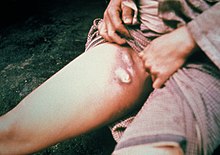Bubo

Abubo(Greek βουβών,boubṓn,'groin') isadenitisor inflammation of thelymph nodesand is an example of reactive infectiouslymphadenopathy.[1]
Classification[edit]
Buboes are a symptom ofbubonic plagueand occur as painful swellings in the thighs, neck, groin or armpits.[2]They are caused byYersinia pestisbacteria spreading fromfleabites through the bloodstream to the lymph nodes, where the bacteria replicate, causing the nodes to swell.[3]Plague buboes may turn black andnecrotic,rotting away the surrounding tissue, or they may rupture, discharging large amounts ofpus.[3]Infectioncan spread from buboes around the body, resulting in other forms of the disease such aspneumonic plague.[4]
Management[edit]
Plague patients whose buboes swell to such a size that they burst tend to survive the disease.[3]Before the discovery ofantibiotics,doctors oftendrainedbuboes with leeches or heated rods to save patients.[3][5]
Buboes are also symptoms of other diseases, such aschancroidandlymphogranuloma venereum.[6][7]In these conditions, a two-week course of antibiotics is the recommended treatment, and incision and drainage or excision of the swollen lymph nodes is best avoided.[8][9]However,aspirationmay sometimes be performed to prevent buboes from rupturing.[9]Although incision and drainage yields better results in such cases—since usually no further intervention is necessary, whereas repeat aspirations may be required—incision and drainagewounds may heal more slowly, increasing the risk of secondary infection.[9]
References[edit]
- ^Drancourt, Michel; Piarroux, Renaud; Bitam, Idir; Mouffok, Nadjet; Raoult, Didier (2013-01-01)."Plague: History and contemporary analysis".Journal of Infection.66(1): 18–26.doi:10.1016/j.jinf.2012.09.010.ISSN0163-4453.PMID23041039.
- ^Paul, Slack (2012).Plague: a very short introduction.New York: Oxford University Press. p. 5.ISBN9780199589548.OCLC749871251.
- ^abcdOrent, Wendy (2004).Plague: the mysterious past and terrifying future of the world's most dangerous disease.New York: Free Press.ISBN978-0743236850.OCLC54034997.
- ^Isberg, Ralph R.; Davis, Kimberly M. (2014-09-18)."Plague's Partners in Crime".Immunity.41(3): 347–349.doi:10.1016/j.immuni.2014.09.003.ISSN1074-7613.PMID25238090.
- ^Nesfield, V.B. (1911). "The treatment of bubonic plague by the immediate incision of the glands".The Lancet.178(4601): 1262–1264.doi:10.1016/S0140-6736(01)42126-X.
- ^Lewis, D. A. (2003-02-01)."Chancroid: clinical manifestations, diagnosis, and management".Sexually Transmitted Infections.79(1): 68–71.doi:10.1136/sti.79.1.68.ISSN1368-4973.PMC1744597.PMID12576620.
- ^Morse, Stephen A.; Holmes, King K.; Moreland, Adele A.; Ballard, Ronald C. (2011).Atlas of sexually transmitted diseases and AIDS(4th ed.). Edinburgh: Saunders/Elsevier.ISBN9780702047640.OCLC761212082.
- ^"Guidelines for the Management of Sexually Transmitted Infections. February 2004: 2. TREATMENT OF STI-ASSOCIATED SYNDROMES: 2.2. Genital ulcer: Inguinal bubo"(PDF).apps.who.int.Retrieved2019-02-13.
- ^abcLewis, David A (2014). "Epidemiology, clinical features, diagnosis and treatment of Haemophilus ducreyi – a disappearing pathogen?".Expert Review of Anti-infective Therapy.12(6): 687–696.doi:10.1586/14787210.2014.892414.ISSN1478-7210.PMID24597521.
